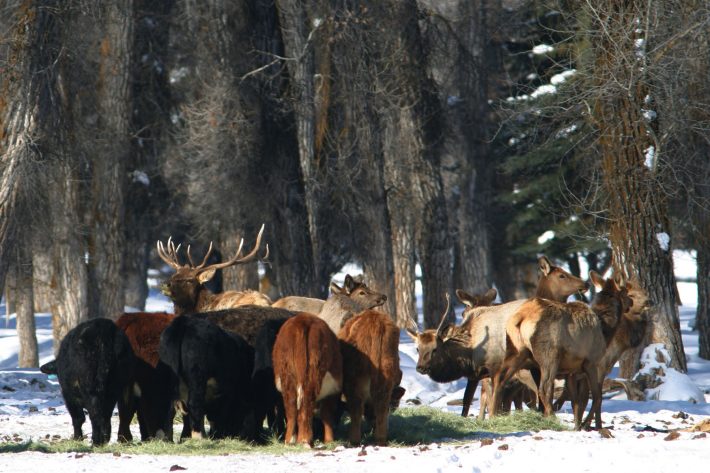New mapping tool tracks elk migration to reduce brucellosis risk
University of Wyoming press release
Wildlife managers and ranchers in the greater Yellowstone ecosystem soon will have a new mapping tool for reducing the risk of brucellosis outbreaks in cattle. That’s thanks to research led by scientists at the University of Wyoming (UW) and the U.S. Geological Survey, which is published in the Journal of Applied Ecology today.

The team of biologists built a computer model of elk behavior during spring migration to identify habitats with the highest risk of brucellosis spilling over from elk to cattle.
Brucellosis is a bacterial disease carried by elk and bison that can cause pregnant females to abort their fetuses. It is transmitted by direct contact with the infected placenta, fetus or birthing fluid.
Cattle can be infected by commingling with elk between February and June. Transmission peaks from March to May, the same months when most elk migrate to calving grounds and mountain summer ranges.
The scientists’ migration model tracks spring snowmelt and green-up of forage to predict where elk will be when they abort. That information is crucial for managers charged with preventing disease transmission.
If a cattle herd contracts the disease, it can lead to herd quarantines, increased testing and potential culling of the index herd and any contact herds sharing a fence line. These movement restrictions can be very costly for cattle producers.
“Keeping elk and cattle separate during that crucial migration period ensures cattle don’t come into contact with brucellosis,” says Jerod Merkle, a postdoctoral researcher with the Wyoming Migration Initiative at UW.
Merkle was lead author on a paper recently published in the Journal of Applied Ecology, a leading publication in the field.
Using GPS collar data from nearly 300 elk captured on supplemental feedgrounds in Wyoming, the team of researchers built models of elk movement that decipher how elk respond to snow depth, plant green-up and other landscape features such as slope and aspect.
The researchers then simulated elk distribution at daily intervals across five weather scenarios, varying the amount of winter snow and the timing of spring green-up.
Given an average population of about 15,000 adult and yearling female elk in the southern greater Yellowstone ecosystem during the study period, the team’s model predicts that, on average, about 700 abortions occur per year.
As expected, the modeled distribution of where these abortions occur varies drastically depending on when snowmelt and green-up happen.
In an average snow year, about 33 percent of the abortions occur within 1.5 miles of feedgrounds; 43 percent occur on national forests; 12 percent occur on private land; 7 percent occur on national parks or national wildlife refuges; and the rest occur across Bureau of Land Management, state and local government lands.
During heavy snow years, the model showed the highest brucellosis transmission risk at lower elevations on or near feedgrounds, because elk are likely to abort before they migrate into the mountains.
In years of winter drought with little snowfall, the modeled rate of abortions on feedgrounds declined 64 percent compared to heavy snow years. That’s because elk migrated earlier in the calving season and were more likely to abort on higher-elevation transitional and summer ranges on other public lands (mainly national forests).
Notably, the research team predicted little difference in the number of abortions that occur on private lands across the weather scenarios.
While cattle in Wyoming are essentially free of brucellosis today thanks to testing and antibiotics, bovines were the original hosts from which the bacteria infected elk populations. Efforts to inoculate free-ranging elk against the disease have been largely unsuccessful, leading managers to turn to management measures to reduce the risk of disease transmission.
Recent mitigation work by the Wyoming Game and Fish Department has focused on changing practices at state-operated elk feedgrounds. By spreading out hay over larger areas of feedgrounds, and shortening the period of feeding, wildlife managers can reduce the chances of an elk aborting its fetus in a crowded situation where other elk would be exposed. That, in turn, may help lower the prevalence of the disease in elk and the risk of transmission to cattle.
Importantly, the new modeling tool helps managers prioritize mitigation responses in areas outside of feedgrounds, by responding to when and where elk migrate during calving season.
“Wildlife and livestock managers can utilize this model to focus prevention efforts in high-risk areas and minimize disease transmission,” says Brandon Scurlock, leader of the Wyoming Game and Fish Department brucellosis program.
Strategies to reduce elk and cattle contact include hazing elk away from cattle feeding areas, or postponing cattle turnout dates until risk of brucellosis transmission has subsided.
This research was conducted in collaboration with the Game and Fish Department and supported by the U.S. Department of Agriculture National Institute of Food and Agriculture, National Science Foundation, Greater Yellowstone Interagency Brucellosis Committee, Grand Teton National Park, the National Elk Refuge (U.S. Fish and Wildlife Service) and U.S. Geological Survey.
Read the full article (freely available for a limited time):
Merkle JA, Cross PC, Scurlock BM, et al. Linking spring phenology with mechanistic models of host movement to predict disease transmission risk. J Appl Ecol. 2017;00:1–10. DOI: 10.1111/1365-2664.13022
Media contact:
Jerod Merkle, University of Wyoming, Email: jmerkle@uwyo.edu, Tel: +1 (307) 766 5448
Like what we stand for?
Support our mission and help develop the next generation of ecologists by donating to the British Ecological Society.